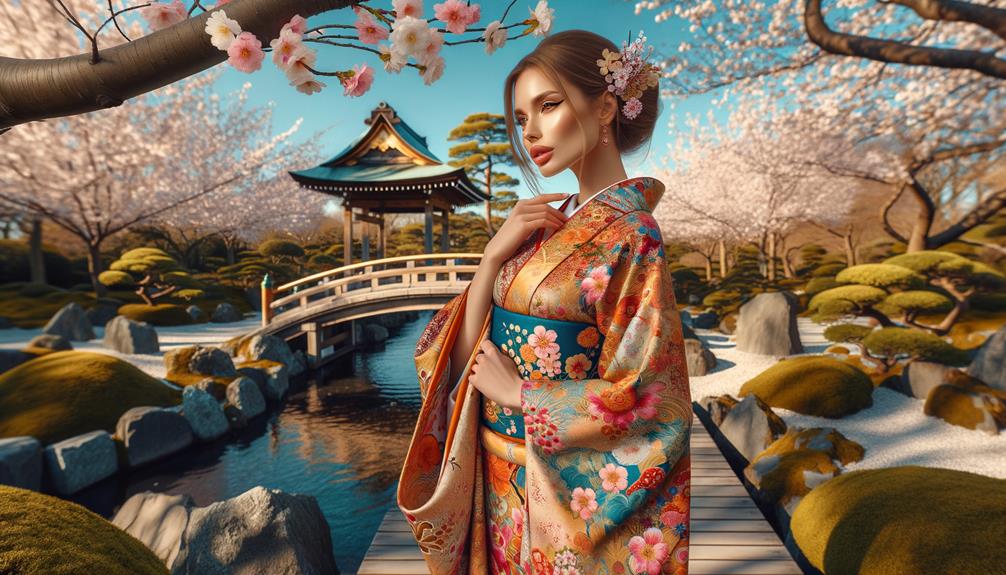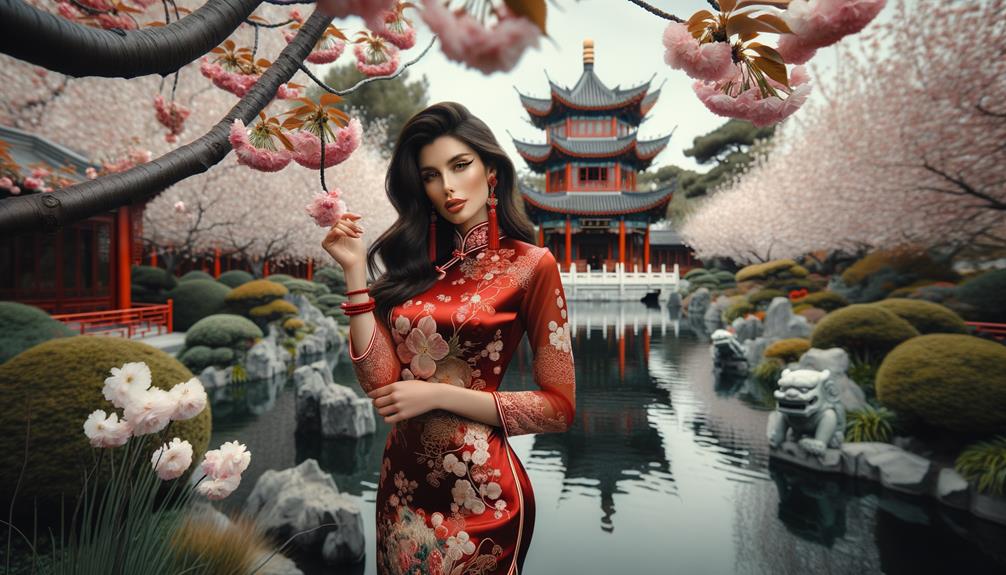Encountering a huipil for the first time, its vibrant colors and intricate patterns captivated me. Each stitch seemed to whisper stories from the past. These blouses preserve centuries-old Mesoamerican traditions through their handcrafted designs. I pondered the hands that wove them, the natural dyes that brought them to life, and the regional variations that make each piece unique. A profound sense of history is woven into every thread, inviting exploration into their enduring cultural significance.
History and Origins
The huipil has been a part of Mesoamerican culture for centuries, serving as both clothing and a representation of identity. When I first encountered one, I was captivated by its vibrant hues and intricate patterns. This traditional blouse, worn by indigenous women in Mexico and Central America, holds far more significance than mere apparel; it's a tapestry of history.
The term 'huipil' originates from Nahuatl, the language of the Aztecs, and it has been a staple garment for many generations. Each huipil's design tells a unique story, reflecting the cultural identity of the region it hails from. It's remarkable how a single garment can carry such profound meaning and history within its threads.
Typically crafted from cotton or other natural fibers, huipils are hand-embroidered, a craft passed down through generations. This preservation of technique ensures that each piece remains a symbol of Mesoamerican heritage. The dedication it takes to maintain such artistry is truly admirable. The huipil transcends being merely clothing; it is a living connection to the past, interwoven with the spirit of the Mexican people.
Cultural Significance
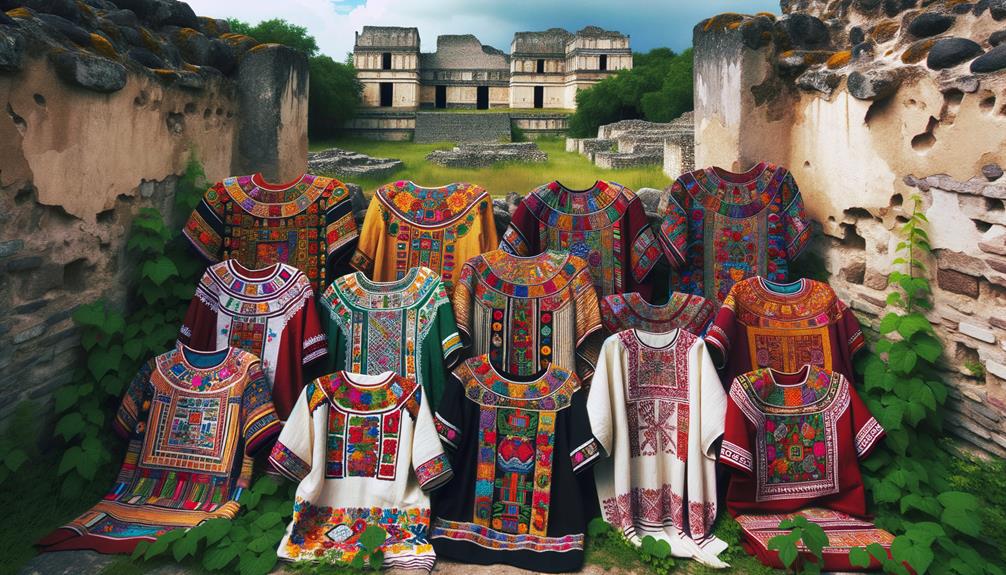
Every huipil dress hides a tale, stitched with care by Indigenous artisans. The vibrant colors and intricate patterns communicate the wearer's identity, hometown traditions, and heritage. It's more than clothing – each thread shares stories of spirituality, nature's rhythms, and daily life.
These elements shine through:
Colors signify marital status and social roles, patterns link to community roots, natural fibers connect to the land, and the painstaking hand embroidery demonstrates masterful skill.
Huipils bridge past and present, resilience made tangible. The stitched symbols are a cultural language, expressing centuries-old worldviews in wearable art. True ambassadors of Mesoamerican peoples, these garments interweave identity and ancestry.
Regional Variations
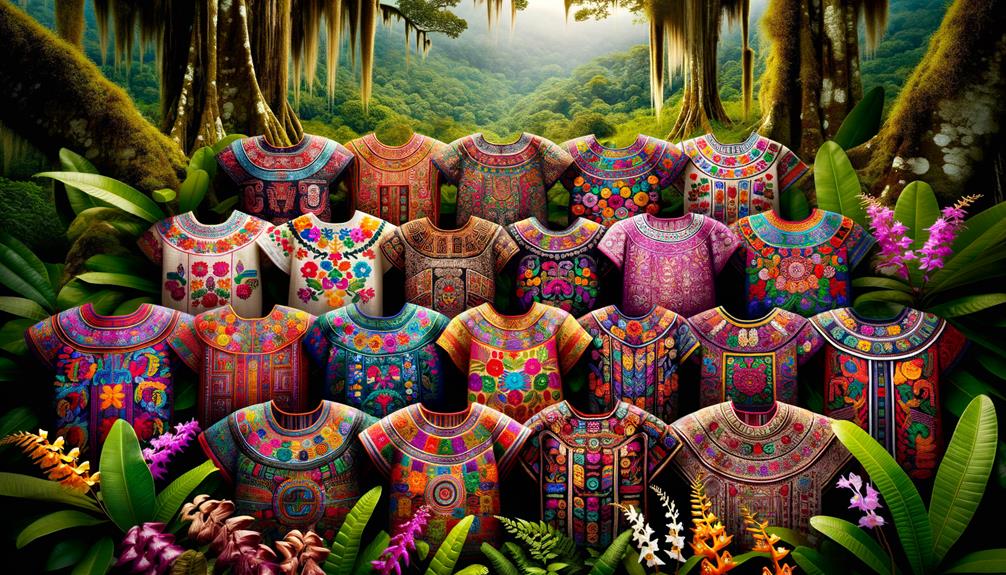
Huipil blouses narrate captivating regional stories, intricately woven by diverse Mesoamerican cultures. Traversing these vibrant landscapes unveils a kaleidoscope of regional artistry within each garment's fabric.
In Oaxaca, skillful artisans meticulously embroider floral motifs, symbolizing fertility and nature's abundance. Meanwhile, Chiapas region blouses exude distinct flair through bold geometric patterns and vivid color contrasts, mirroring the area's rich cultural tapestry.
Altitude influences color palettes – highlands favor deep, earthy tones, while coastal regions embrace vibrant, tropical hues. Patterns transcend aesthetics, encoding ancestral lineages or local folklore, rendering each design profoundly personal.
These regional nuances reflect a community's spirit. For instance, Chiapas embroidery encapsulates the region's resilience and creativity. Appreciating such distinctions deepens our understanding of the cultural significance ingeniously woven into every huipil.
Craftsmanship Techniques
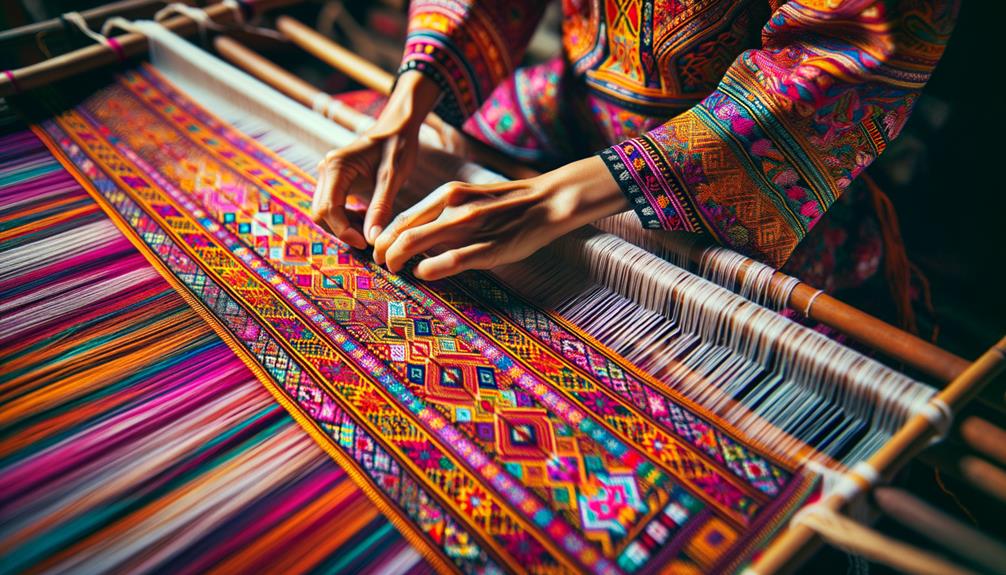
I appreciate the craftsmanship behind huipil blouses, with traditional weaving techniques withstanding generational change. Each pattern and embroidered symbol narrates a distinct cultural story. The natural dyeing methods yield vibrant hues reflecting the artisans' profound heritage connection.
Traditional Weaving Methods
Through generations, skilled artisans meticulously weave Huipil blouses on backstrap looms, reflecting their cultural roots and expertise. Witnessing these craftspeople transform natural fibers into wearable art, each strand intentionally woven, evokes awe. The blouse becomes a canvas adorned with intricate embroidery, each stitch narrating the weaver's mastery and vibrant community traditions.
This intricate, intimate process demands immense patience and a deep connection with the materials. As the backstrap loom's rhythmic motion unfolds, I'm reminded of the dedication required to sustain this ancient practice.
- Cotton or agave fibers underscore sustainability and a bond with the land.
- Each region's motifs and styles make Huipil blouses emblems of local heritage.
- The process marries functionality with beauty, showcasing the weaver's craftsmanship.
- While rooted in history, techniques adapt by incorporating fresh patterns and ideas.
In this dance of hands and loom, tradition coexists with innovation, creating Huipil blouses that are timeless yet contemporary.
Embroidery Patterns Significance
The vivid embroidery on Mexican Huipil blouses tells rich stories through intricate designs infused with cultural heritage and personal touches. Each region boasts distinct styles, from stitching techniques to color combinations, making these garments one-of-a-kind works of art.
Passed down across generations, traditional designs and skills remain vibrant. The craftsmanship demands incredible skill, patience, and attention to detail. Remarkably, certain patterns convey social status, marital status, or community affiliation. These embroidered symbols transcend decoration; they communicate the wearer's identity and ancestry.
Observing these creations reveals the profound bond between artisan and artwork. Every Huipil blouse narrates a tale, and understanding the artisanship behind the embroidered motifs fosters a deep appreciation for the diverse cultural tapestry of Mesoamerican communities.
Dyeing Natural Fabrics
Exploring natural dyeing techniques for Huipil blouses, vibrant fabrics emerge through traditional methods blending foraged plants, bugs, minerals, and barks. Artisans devote immense skill, carefully boiling cotton and manta with dyes extracted from elements like leaves, roots, flowers, cochineal insects, and mineral-rich soil. This eco-friendly approach honors sustainable practices passed through generations.
The resulting hues are more than colors; they represent cultural stories and heritage fused into wearable art. Greens, yellows, and reds from plants intermingle with striking pinks from cochineal bugs and earthy tones from minerals. Rich, warm shades emerge from barks and woods, breathing life into fabrics steeped in tradition.
These Huipil blouses exemplify innovation rooted in age-old dyeing methods, blurring boundaries between nature and culture. Their vibrancy speaks volumes about dedication to craftsmanship and sustainability.
Modern Adaptations
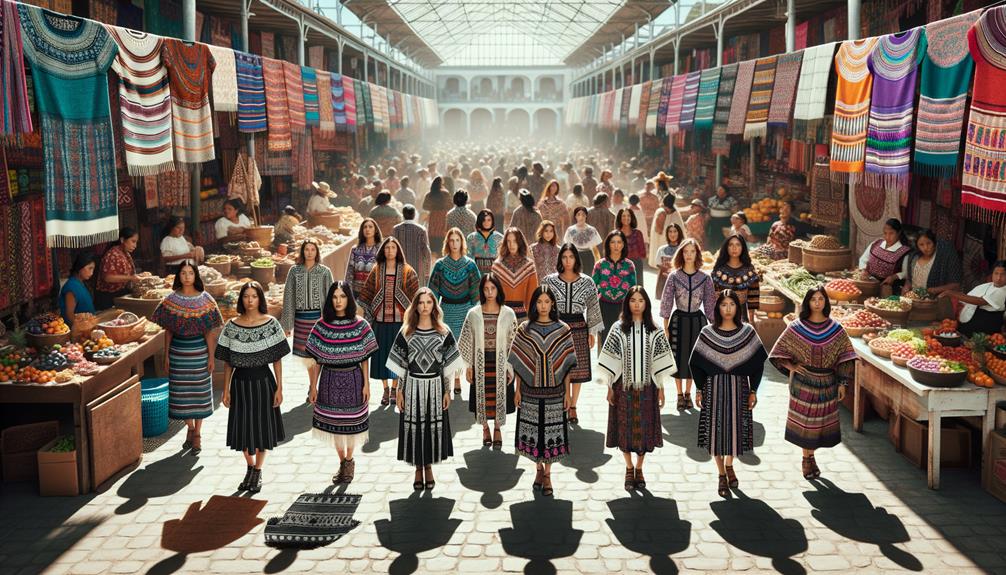
It's fascinating to witness modern designers breathing fresh life into traditional Huipil blouses. They take the classic embroidered Mexican designs and fuse them with contemporary touches, crafting a Huipil blouse that bridges the gap between past and present. I find their experimentation with diverse cuts and styles intriguing, transforming the Huipil from a cultural heritage piece into a versatile fashion statement in today's landscape.
These designers fearlessly play with fabrics, colors, and patterns. They might opt for silk or linen instead of the conventional cotton, or introduce bold, unexpected hues that still pay homage to the original artistry. These modern adaptations honor the Huipil's cultural roots while appealing to a diverse, fashion-forward audience. It's a delicate balance, but when executed well, it creates a beautiful fusion that celebrates tradition and innovation.
What strikes me most is how these adaptations showcase the Huipil's versatility. Whether paired with jeans for a relaxed look or styled with a skirt for a dressier occasion, the Huipil remains a timeless garment that continues to inspire and evolve with the times.
Where to Buy
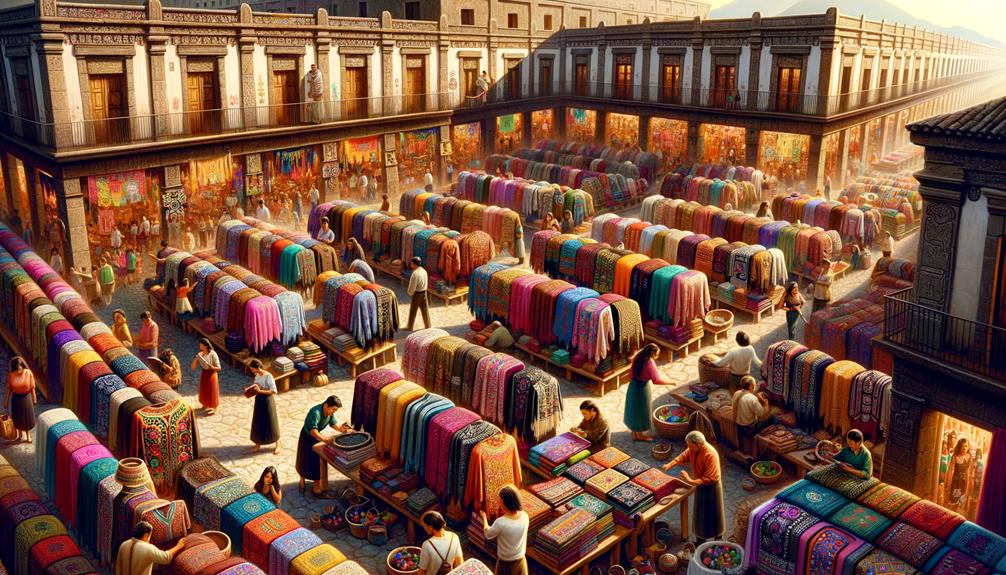
Seeking authentic huipils, local artisan markets offered one-of-a-kind pieces, each telling its own story. For those unable to visit in person, ethical online stores provide a convenient way to support traditional craftsmanship while cultural heritage shops ensure these vibrant blouses remain accessible to admirers everywhere.
Local Artisan Markets
Mexican artisan markets offer a genuine cultural immersion. As you wander between stalls, vibrant handcrafted Huipil blouses catch your eye, each distinct in pattern and color. These traditional garments embody Mesoamerican heritage, transcending mere clothing—they're portals into the region's rich tapestry.
The shopping experience itself captivates. Authenticity reigns, with skilled artisans crafting each one-of-a-kind piece. Styles, hues, and sizes abound, ensuring diverse preferences are met. More importantly, your purchase directly uplifts local artisans and families, fostering sustainable livelihoods.
But the true beauty lies in the cultural connection. Intricate patterns and vivid colors reflect the soul of their makers—glimpses into Mesoamerican histories and traditions. These markets aren't just retail hubs; they're living celebrations of Mexican ethnic artistry. Wandering the stalls feels deeply personal, tangibly linking past and present.
Online Ethical Stores
Online ethical stores unveil a world of Mesoamerican huipil blouses bursting with artistry from regions like Oaxaca and Guerrero. Each blouse radiates tradition and innovation, effortlessly blending boho chic with timeless cultural elements. The intricate hand-embroidered patterns on soft cotton manta cloth exemplify the artisans' dedication and skill.
Navigating these digital marketplaces, each piece transcends being a simple garment, weaving a story rich with care. Vibrant hues and traditional motifs honor the cultural tapestry of Mesoamerica, transforming each huipil into a unique statement piece. Whether seeking casual or special occasion wear, these blouses cater to varied styles.
Notably, purchasing these blouses upholds fair trade practices. Supporting indigenous craftsmanship and empowering artisans feels rewarding amidst the fast fashion landscape. Finding these ethical options online uncovers a hidden gem, allowing one to wear art with a clear conscience.
Cultural Heritage Shops
Finding that perfect embroidered huipil blouse often takes me to cultural shops celebrating tradition and skilled artisanship. These places showcase intricate handmade pieces that tell stories from Mexico's diverse indigenous cultures through vibrant colors and embroidery patterns.
Stepping into one of these shops instantly transports me. Vintage huipils from across Mexico line the walls, each a unique expression of its maker's art. These are a few reasons why I frequent cultural shops for huipils:
- Authenticity: They source directly from artisans, ensuring genuine regional craftsmanship.
- Skilled labor: Blouses showcase painstaking handwork, mastered through generations.
- Cultural preservation: Purchases support indigenous communities sustaining heritage.
- One-of-a-kind pieces: Each huipil's design makes my wardrobe truly distinctive.
Beyond building my closet, shopping these cultural gems connects me to the living traditions woven into Mexico's indigenous textiles. It celebrates the creativity and resilience of communities shaping their art against all odds.
Frequently Asked Questions
What Is a Mayan Blouse Called?
A Mayan huipil is much more than a traditional blouse – each one tells a unique cultural story woven into its intricate patterns. These vibrant garments seamlessly blend age-old customs with fresh artistry, showcasing the enduring creativity of Mayan textile makers. Their contemporary designs draw inspiration from historical motifs, ensuring the timeless elegance of this traditional attire continues to dazzle in the modern era.
Why Do Mexicans Wear Huipiles?
Huipiles connect Mexicans to indigenous heritage, flaunting exceptional artistry and community spirit. These vibrant garments represent cultural preservation in a distinct, down-to-earth manner. Wearing huipiles is a tangible way for Mexicans to honor their roots while taking pride in local craftsmanship.
What Does a Huipil Represent?
A huipil reflects generations of cultural identity and skill passed down through beautifully embroidered fabrics. Every stitch encapsulates stories of resilience and celebration, weaving a vibrant tapestry that honors a community's enduring heritage. These garments transcend mere attire – they carry the living spirit of ancestors' traditions into the modern era.
Are Huipiles Mayan?
A huipil isn't solely a Mayan garment; indigenous groups like the Nahua, Zapotec, and Mixtec also wear these colorful blouses. Each design reflects the rich cultural heritage and intricate traditions of the respective community. Seeing women don these vibrant textiles showcases the diversity of styles across different regions.



